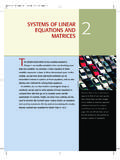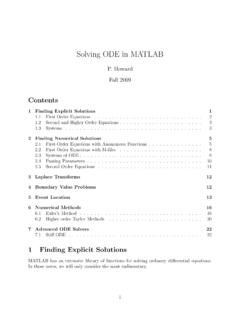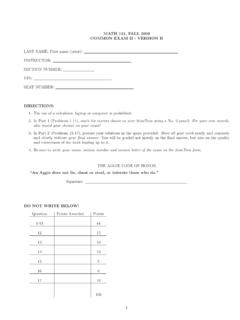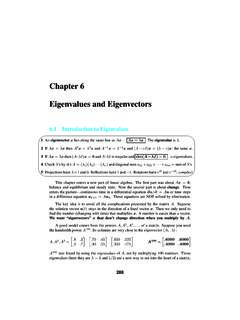Transcription of MATH 304 Linear Algebra - Texas A&M University
1 MATH 304. Linear Algebra Lecture 14: Basis and coordinates. Change of basis. Linear transformations. Basis and dimension Definition. Let V be a vector space. A linearly independent spanning set for V is called a basis. Theorem Any vector space V has a basis. If V. has a finite basis, then all bases for V are finite and have the same number of elements (called the dimension of V ). Example. Vectors e1 = (1, 0, 0, .. , 0, 0), e2 = (0, 1, 0, .. , 0, 0),.. , en = (0, 0, 0, .. , 0, 1). form a basis for Rn (called standard) since (x1 , x2 , .. , xn ) = x1 e1 + x2 e2 + + xn en . Basis and coordinates If {v1 , v2 , .. , vn } is a basis for a vector space V , then any vector v V has a unique representation v = x1 v1 + x2 v2 + + xn vn , where xi R. The coefficients x1 , x2 , .. , xn are called the coordinates of v with respect to the ordered basis v1 , v2.
2 , vn . The mapping vector v 7 its coordinates (x1 , x2 , .. , xn ). is a one-to-one correspondence between V and Rn . This correspondence respects Linear operations in V. and in Rn . Examples. Coordinates of a vector v = (x1 , x2 , .. , xn ) Rn relative to the standard basis e1 = (1, 0, .. , 0, 0), e2 = (0, 1, .. , 0, 0),.. , en = (0, 0, .. , 0, 1) are (x1 , x2 , .. , xn ).. Coordinates of a matrix ca b d M2,2 (R).. 1 0 0 0 0 1. relative to the basis 0 0. , 1 0. , 0 0. , . 0 0. 0 1. are (a, c, b, d). Coordinates of a polynomial p(x) = a0 + a1 x + + an 1 x n 1 Pn relative to the basis 1, x, x 2 , .. , x n 1 are (a0 , a1 , .. , an 1 ). Vectors u1 =(2, 1) and u2 =(3, 1) form a basis for R2 . Problem 1. Find coordinates of the vector v = (7, 4) with respect to the basis u1 , u2.
3 The desired coordinates x, y satisfy . 2x + 3y = 7 x =5. v = xu1 +y u2 . x +y =4 y = 1. Problem 2. Find the vector w whose coordinates with respect to the basis u1 , u2 are (7, 4). w = 7u1 + 4u2 = 7(2, 1) + 4(3, 1) = (26, 11). Change of coordinates Given a vector v R2 , let (x, y ) be its standard coordinates, , coordinates with respect to the standard basis e1 = (1, 0), e2 = (0, 1), and let (x , y ) be its coordinates with respect to the basis u1 = (3, 1), u2 = (2, 1). Problem. Find a relation between (x, y ) and (x , y ). By definition, v = xe1 + y e2 = x u1 + y u2 . In standard coordinates, . x 3 2 3 2 x =x . +y . =. y 1 1 1 1 y . 1 . x 3 2 x 1 2 x = = =. y . 1 1 y 1 3 y Change of coordinates in Rn The usual (standard) coordinates of a vector v = (x1 , x2 , .. , xn ) Rn are coordinates relative to the standard basis e1 = (1, 0.)
4 , 0, 0), e2 = (0, 1, .. , 0, 0),.. , en = (0, 0, .. , 0, 1). Let u1 , u2 , .. , un be another basis for Rn and (x1 , x2 , .. , xn ). be the coordinates of the same vector v with respect to this basis. Problem 1. Given the standard coordinates (x1 , x2 , .. , xn ), find the nonstandard coordinates (x1 , x2 , .. , xn ). Problem 2. Given the nonstandard coordinates (x1 , x2 , .. , xn ), find the standard coordinates (x1 , x2 , .. , xn ). It turns out that . x1 u11 u12 .. u1n x1.. x2 u21 u22 .. u2n x2 .. = .. xn un1 un2 .. unn xn . The matrix U = (uij ) does not depend on the vector x. Columns of U are coordinates of vectors u1 , u2 , .. , un with respect to the standard basis. U is called the transition matrix from the basis u1 , u2 , .. , un to the standard basis e1 , e2.
5 , en . This solves Problem 2. To solve Problem 1, we have to use the inverse matrix U 1 , which is the transition matrix from e1 , .. , en to u1 , .. , un . Problem. Find coordinates of the vector x = (1, 2, 3) with respect to the basis u1 = (1, 1, 0), u2 = (0, 1, 1), u3 = (1, 1, 1). The nonstandard coordinates (x , y , z ) of x satisfy . x 1. y = U 2 , z 3. where U is the transition matrix from the standard basis e1 , e2 , e3 to the basis u1 , u2 , u3 . The transition matrix from u1 , u2 , u3 to e1 , e2 , e3 is . 1 0 1. U0 = (u1 , u2 , u3 ) = 1 1 1 . 0 1 1. The transition matrix from e1 , e2 , e3 to u1 , u2 , u3 is the inverse matrix: U = U0 1 . The inverse matrix can be computed using row reduction.. 1 0 1 1 0 0. (U0 | I ) = 1 1 1 0 1 0 . 0 1 1 0 0 1.. 1 0 1 1 0 0 1 0 1 1 0 0.
6 0 1 0 1 1 0 0 1 0 1 1 0 . 0 1 1 0 0 1 0 0 1 1 1 1.. 1 0 0 0 1 1. 0 1 0 1 1 0 = (I | U0 1 ). 0 0 1 1 1 1. Thus . x 0 1 1 1 1. y = 1 1 0 2 =. 1 . z . 1 1 1 3 2. Change of coordinates: general case Let V be a vector space of dimension n. Let v1 , v2 , .. , vn be a basis for V and g1 : V Rn be the coordinate mapping corresponding to this basis. Let u1 , u2 , .. , un be another basis for V and g2 : V Rn be the coordinate mapping corresponding to this basis. V. g1 g2.. Rn Rn The composition g2 g1 1 is a transformation of Rn . It has the form x 7 Ux, where U is an n n matrix. U is called the transition matrix from v1 , v2 .. , vn to u1 , u2 .. , un . Columns of U are coordinates of the vectors v1 , v2 , .. , vn with respect to the basis u1 , u2 , .. , un . Problem. Find the transition matrix from the basis p1 (x) = 1, p2 (x) = x + 1, p3 (x) = (x + 1)2.
7 To the basis q1 (x) = 1, q2 (x) = x, q3 (x) = x 2 for the vector space P3 . We have to find coordinates of the polynomials p1 , p2 , p3 with respect to the basis q1 , q2 , q3 : p1 (x) = 1 = q1 (x), p2 (x) = x + 1 = q1 (x) + q2 (x), p3 (x) = (x+1)2 = x 2 +2x+1 = q1 (x)+2q2 (x)+q3 (x).. 1 1 1. Hence the transition matrix is 0 1 2 . 0 0 1. Thus the polynomial identity a1 + a2 (x + 1) + a3 (x + 1)2 = b1 + b2 x + b3 x 2. is equivalent to the relation . b1 1 1 1 a1. b2 = 0 1 2 a2 . b3 0 0 1 a3. Problem. Find the transition matrix from the basis v1 = (1, 2, 3), v2 = (1, 0, 1), v3 = (1, 2, 1) to the basis u1 = (1, 1, 0), u2 = (0, 1, 1), u3 = (1, 1, 1). It is convenient to make a two-step transition: first from v1 , v2 , v3 to e1 , e2 , e3 , and then from e1 , e2 , e3 to u1 , u2 , u3.
8 Let U1 be the transition matrix from v1 , v2 , v3 to e1 , e2 , e3 and U2 be the transition matrix from u1 , u2 , u3 to e1 , e2 , e3 : . 1 1 1 1 0 1. U1 = 2 0 2 , U2 = 1 1 1 . 3 1 1 0 1 1. Basis v1 , v2 , v3 = coordinates x Basis e1 , e2 , e3 = coordinates U1 x Basis u1 , u2 , u3 = coordinates U2 1 (U1 x) = (U2 1 U1 )x Thus the transition matrix from v1 , v2 , v3 to u1 , u2 , u3 is U2 1 U1 . 1 . 1 0 1 1 1 1. U2 1 U1 = 1 1 1 2 0 2 . 0 1 1 3 1 1.. 0 1 1 1 1 1 1 1 1. = 1 1 0 2 0 2 = 1 1 1 . 1 1 1 3 1 1 2 2 0. Linear mapping = Linear transformation = Linear function Definition. Given vector spaces V1 and V2 , a mapping L : V1 V2 is Linear if L(x + y) = L(x) + L(y), L(r x) = rL(x). for any x, y V1 and r R. A Linear mapping : V R is called a Linear functional on V . If V1 = V2 (or if both V1 and V2 are functional spaces) then a Linear mapping L : V1 V2 is called a Linear operator.
9 Linear mapping = Linear transformation = Linear function Definition. Given vector spaces V1 and V2 , a mapping L : V1 V2 is Linear if L(x + y) = L(x) + L(y), L(r x) = rL(x). for any x, y V1 and r R. Remark. A function f : R R given by f (x) = ax + b is a Linear transformation of the vector space R if and only if b = 0. Examples of Linear mappings Scaling L : V V , L(v) = sv, where s R. L(x + y) = s(x + y) = sx + sy = L(x) + L(y), L(r x) = s(r x) = r (sx) = rL(x). Dot product with a fixed vector : Rn R, (v) = v v0 , where v0 Rn . (x + y) = (x + y) v0 = x v0 + y v0 = (x) + (y), (r x) = (r x) v0 = r (x v0 ) = r (x). Cross product with a fixed vector L : R3 R3 , L(v) = v v0 , where v0 R3 . Multiplication by a fixed matrix L : Rn Rm , L(v) = Av, where A is an m n matrix and all vectors are column vectors.
10 Linear mappings of functional vector spaces Evaluation at a fixed point : F (R) R, (f ) = f (a), where a R. Multiplication by a fixed function L : F (R) F (R), L(f ) = gf , where g F (R). Differentiation D : C 1 (R) C (R), L(f ) = f . D(f + g ) = (f + g ) = f + g = D(f ) + D(g ), D(rf ) = (rf ) = rf = rD(f ). Integration over a finite Z b interval : C (R) R, (f ) = f (x) dx, where a a, b R, a < b.











